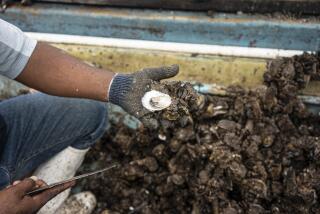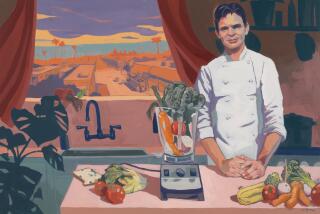Child Criticizes Contamination of U. S. Seafood
Julia Child, renowned cookbook author and television personality, sharply criticized the shellfish industry recently for failing to address the microbiological contamination increasingly found in these species.
Child’s comments on food safety, a departure from her trademark cooking presentations and lectures, were made at the annual meeting of the Newspaper Food Editors and Writers Assn. in Providence, R.I.
“I’m concerned about the pollution in shellfish . . . It’s a terrible problem,” said Child.
In fact, Child no longer eats clams, oysters or mussels as a result of the viruses and bacteria associated with the bivalves.
“I haven’t been eating shellfish (and won’t) till I find out more about (the extent of the contamination). I love them, but I’m staying away,” she said in an interview with The Times after her formal appearance.
Child, 76, the grande dame of American food authorities, said she is having difficulty getting government officials or seafood industry representatives to provide adequate answers to her concerns about shellfish.
“I’ve spoken to people in both industry and government and they won’t even touch shellfish,” she said.
Child’s criticism comes at a time when several consumer groups are urging the federal government to intensify oversight of fishery products. Even though all processors and distributors must conform to federal regulations, only a small percentage of the fish and shellfish sold in this country is inspected for wholesomeness by government agents.
In particular, shellfish availability has been reduced somewhat by pollution along the East Coast and the Gulf of Mexico.
For example, federal health officials issued an advisory earlier this year urging consumers to avoid eating uncooked Gulf oysters from April to October. The warning was thought necessary because about 40% of the shellfish harvested from the gulf during this period contain Vibrio vulnificus, a potentially harmful virus. Cooking the shellfish is a means of destroying the pathogen and ensuring safety. However, the most popular method of oyster consumption remains on-the-half shell or raw.
“There are viruses in (contaminated) shellfish that can (even cause) hepatitis. And you have to cook the bivalves thoroughly to destroy (some of the organisms), but who wants to cook an oyster till it’s a piece of cement?” Child said.
She even casts doubt on one of the few federal precautions required of shellfish brokers: Each shipment must be labeled to identify the harvesting region in the event a recall is ordered for a particular area’s catch.
“Can you really tell where these (items) are from?” she asked, suggesting that those species harvested from unclean waters often remain in commerce.
Child also offered comments on several other food topics.
She downplayed, for instance, the threat posed by pesticide residues on produce: “With 250 million people in this country to feed, if there is no (chemical) spraying then there will be no potatoes (as well as other important crops),” Child said.
Poultry producers, still recovering from studies that showed widespread salmonella contamination in processed chicken, also received some encouragement.
“The reason chicken is inexpensive today is that flocks are raised in such large quantities. And where salmonella (a harmful bacteria) flares up, we need to watch it carefully. But scientists are working hard on reducing that,” she said.
Child found, however, that news coverage of these issues is sometimes lacking.
“They (the media) give you a terrible scare (about food safety) and then never follow up--such as with the salmonella contamination of eggs (in the Northeastern United States),” she said. “According to the Massachsettes Department of Agriculture there is nothing (in terms of contaminants) in the eggs at this point,” a development that has not been covered by the media, she said. “We need more follow-up (in news reports).”
Child also bemoaned popular misconceptions about nutrition, particularly those fostered by television commercials.
“Knowledge of nutrition today is minimal because of all these TV ads about fiber, calcium and other things. This will lead to poor health and make people afraid of foods--foods like beef or a nice, marbled steak. Now that gives you strength. Or make people afraid of eggs,” she said. “People don’t have any real knowledge of health and nutrition. We are all just listening to (and following) the last thing we heard on TV.”
And finally, Child spoke of her passion--cooking.
“In the old days, cooking was considered blue-collar . . . But the world has changed and cooking is now recognized as an art form. Food and wine--and the study of them--is, indeed, an art form. And it is as important to life as music, architecture and other disciplines,” she said.
“Eventually we will get even more chefs with college degrees in food and gastronomy. And we need this type of good cooking to show what food is really supposed to taste like.”
More to Read
Eat your way across L.A.
Get our weekly Tasting Notes newsletter for reviews, news and more.
You may occasionally receive promotional content from the Los Angeles Times.






